Have you heard the term spinner’s weasel? I hadn’t until a few days ago, when I started researching the photo above. The photo is slightly smaller than a cabinet card and more square. I would tentatively date it to around 1905 (+/- 10 years). On the back, a previous owner wrote the word Shaker, referring to the United Society of Believers, commonly known as the Shakers. I don’t know if the reference is accurate. The photo came to me from Texas, but could have originated elsewhere.
Rather than try to explain the function of a spinner’s weasel, I’ll quote Wikipedia:
A spinner’s weasel consists of a wheel which is revolved by the spinner in order to measure off thread or yarn after it has been produced on the spinning wheel. The weasel is usually built so that the circumference is six feet, so that 40 revolutions produces 80 yards of yarn, which is a skein. It has wooden gears inside and a cam, designed to cause a popping sound after the 40th revolution, telling the spinner that she has completed the skein.
So, the gear directly in front of the woman below had a cam (peg) attached to it which would make a snapping or popping sound after the 40th revolution of the “wheel” holding the yarn:
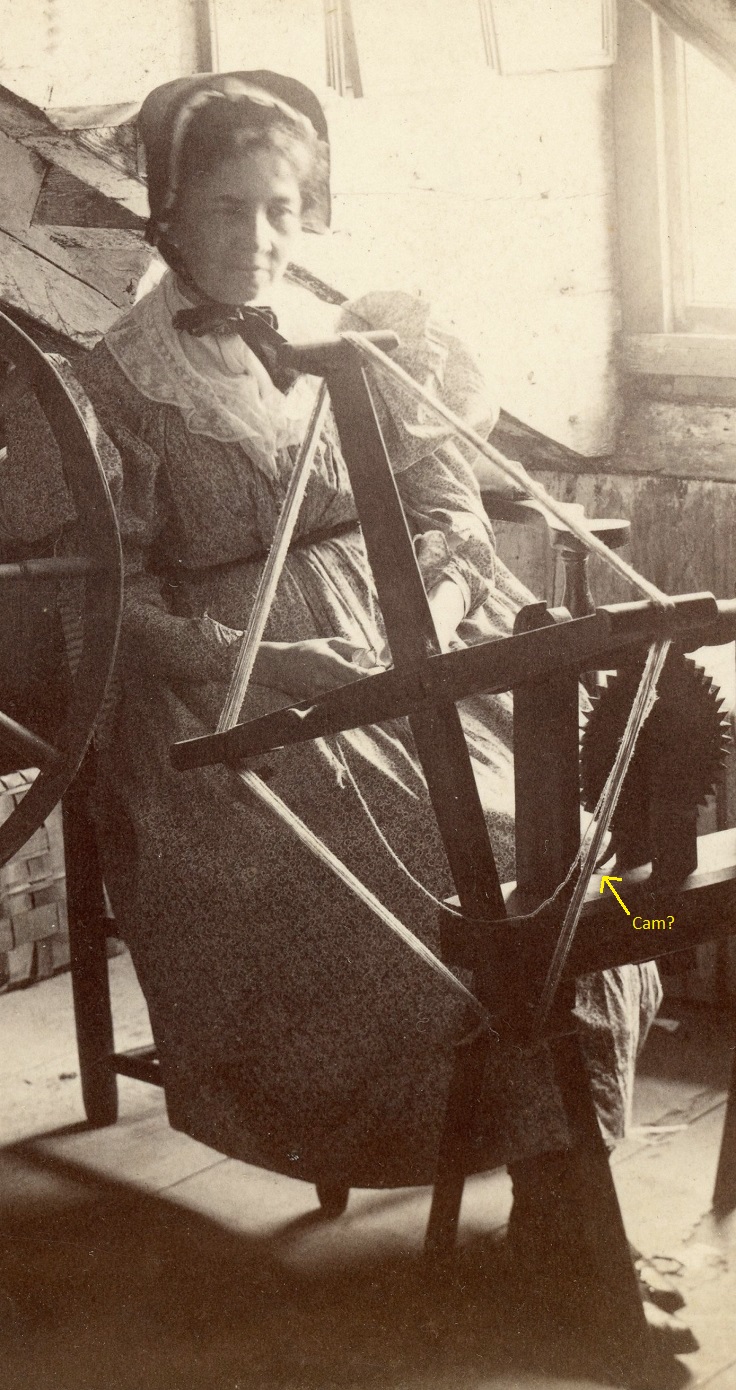
The popping of a spinner’s weasel may have been the inspiration for the English nursery rhyme Pop! Goes the Weasel. The tune came to the Americas in the 1850s as a dance song, with new words added by various publishers. For example, the song’s Wikipedia page has the following:
In her autobiographical novel Little House in the Big Woods, published in 1932, American author Laura Ingalls Wilder recalls her father in 1873 singing the lyrics:
All around the cobbler’s bench,
The monkey chased the weasel.
The preacher kissed the cobbler’s wife –
Pop! goes the weasel!
A penny for a spool of thread,
Another for a needle,
That’s the way the money goes –
Pop! goes the weasel!
Another name for a spinner’s weasel is clock reel. With the new year less than a week old, I can’t help but think about the cyclical nature of the calendar, with the days of the year winding up gradually like a skein of yarn…. On that note, one more verse:
I’ve no time to wait and sigh,
No patience to wait ’til by and by.
Kiss me quick, I’m off, goodbye!
Pop! goes the weasel.

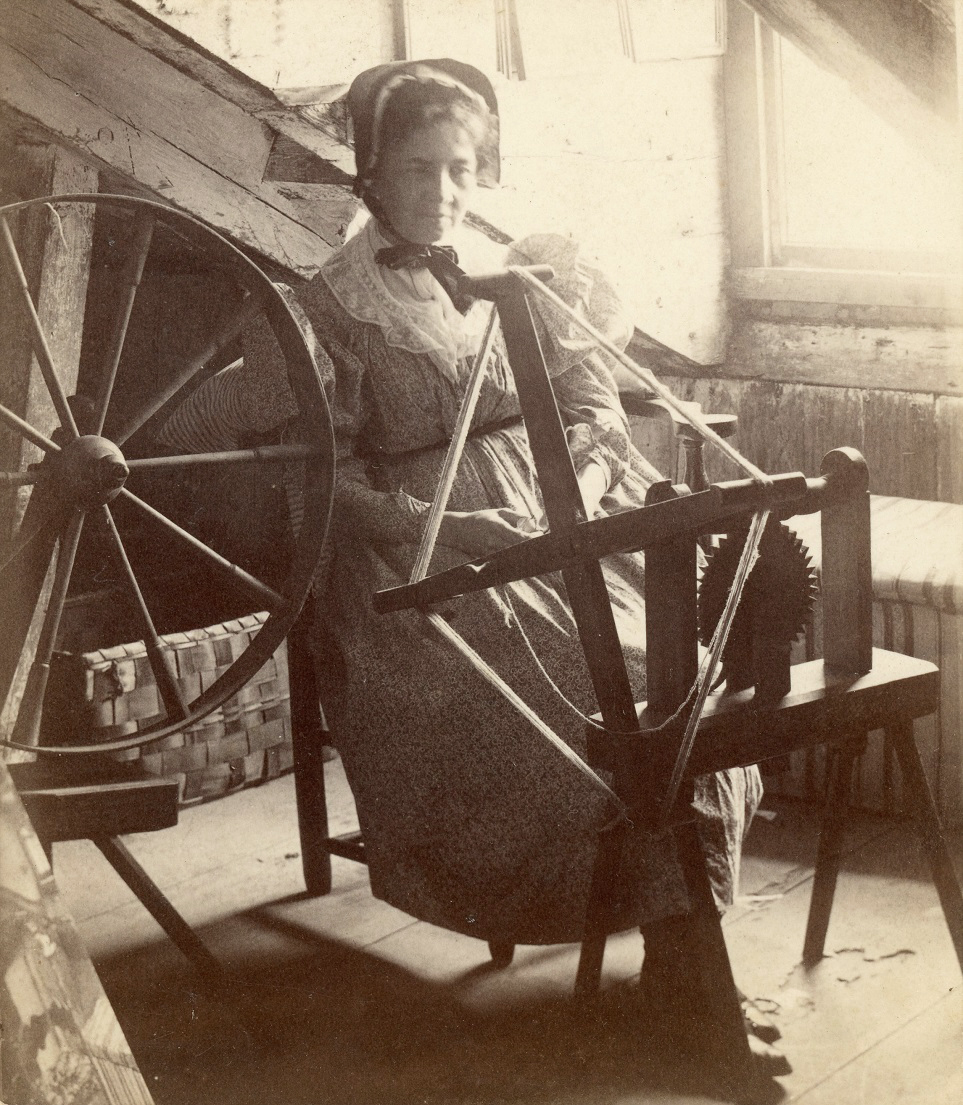
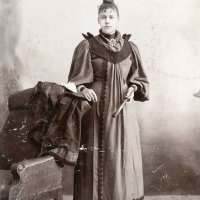
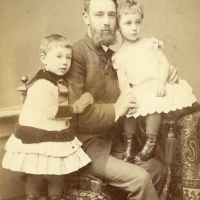
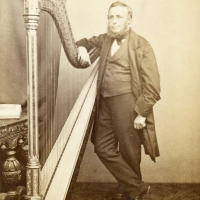
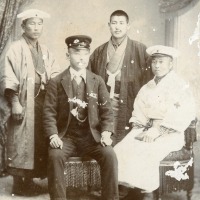
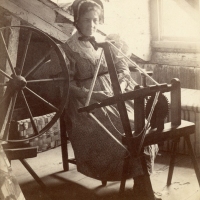
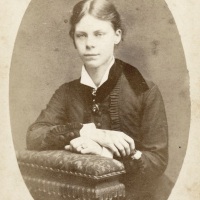
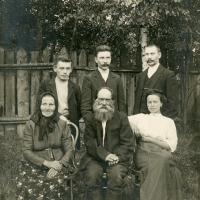
What a fascinating project you have here! So much knowledge available for us life-long learners. It’s interesting to ponder the fact that most of the people in these ‘found’ photographs had no idea they would be discovered decades later and wondered about.
LikeLiked by 3 people
I’ve often wondered if people sitting for early portrait photographs thought the photos might long outlive them, like paintings. Most sitters probably didn’t foresee how long some of the photos would survive, and how interesting the images would be to future generations.
Thank you for your kind words! I love the two poems you’ve shared!
LikeLiked by 2 people
Never heard of a spinner’s weasel but then I don’t know much about spinning. Interesting connection to the song. The lady was dressed nicely – perhaps just for the photo.
LikeLiked by 2 people
It’s quite possible she dressed for the photo. The room looks like an attic or storeroom, rather than a space that was actively used. I wish we knew more. Thanks for reading, Jo Nell!
LikeLike
That nursery rhyme finally makes sense now after reading what a spinner’s weasel is! 🙂 It’s so much fun to imagine what the people in the photos are thinking.
LikeLiked by 3 people
I’d say she looks shy but relaxed in front of the camera. I don’t think the photo was her idea, but she was OK with it. 🙂
LikeLiked by 1 person
How interesting to finally learn where “Pop Goes the Weasel” originated! My grandmother had a similar apparatus from the farm in Nova Scotia, although I don’t remember a cog, and it wasn’t attached to a spinning wheel.
LikeLiked by 2 people
How neat! I bet you wish you still had it.
LikeLiked by 1 person
My cousin Anne has it in her house in Vermont, so it’s still in the family.
LikeLiked by 1 person
That’s wonderful!
LikeLike
Very interesting photo. Her clothing looks too frilly and decorated to be Shaker and she’s not wearing the cap that Shaker women wore. (See: https://home.shakerheritage.org/clothing-style-shaker-communities/)
LikeLiked by 1 person
I read the text on the page you found and looked closely at the photo of the large family. I actually think the bonnet is very similar, but I agree with what you say about her dress. Thank you for the link!
LikeLiked by 1 person
Truly fascinating. Now that ‘pop, goes the weasel’ makes sense. After all these years, it’s quite something to learn that!
LikeLiked by 1 person
Well, I should mention that there are other theories about the song, especially the British lyrics, which mention the Eagle Pub in City Road, London. “Pop” could mean pawn and “weasel” could mean a coat that was pawned to buy beer at the pub. But the theories aren’t mutually exclusive, since people at the time would have understood that the words had multiple meanings. Glad you enjoyed the post, Tracey! 🙂
LikeLike
So interesting! That is definitely a bit of trivia I never would have known were in not for this picture and post. Great research (as always) on your part, Brad!
LikeLiked by 1 person
I stumbled on this completely by accident, but it was too fun not to share. Thanks for reading, Zoe!
LikeLiked by 1 person
That’s a very interesting gadget and so clever to measure out a skein. 🙂
What still amuses me about these old photos is that here is a woman Working – in a bonnet and all her lace – unless she dressed up just for the photo! 😀
LikeLiked by 1 person
She may have dressed up just for the photo. The weasel doesn’t have much yarn on it, and the spinning wheel doesn’t seem to be in use. The room could be an attic or storeroom. On the other hand, there’s plenty of light from the window, so it might have been a good place to work. As usual, more questions than answers. 🙂
LikeLiked by 1 person
Such an interesting post!
LikeLiked by 1 person
Thank you, Lemony! It’s great to see new things from you!
LikeLike
That is such an interesting post – very educational! I have heard the “Pop! goes the weasel” line before, but not the other bits, and it sure is interesting to see what an actual weasel looks like.
LikeLiked by 1 person
Oddly enough, I haven’t found an explanation as to why it’s called a weasel. It’s a strange name! I should look into it…. 🙂
LikeLike
Yes, very strange! Does it have anything to do with the animal? I’ll be interested to follow your research 🙂
LikeLiked by 1 person
This is a very fun and interesting post! All the comments are great, too. I’ve seen something similar, but did not know it was called a weasel or precisely how it functioned.
LikeLiked by 1 person
Thank you! I’ve been trying to learn the origin of the name, so far with no luck. Today I’m going to look in my grandparents’ OED. That’s something I haven’t done in a while! That magnifying glass is around here somewhere….
LikeLiked by 1 person
The lady in the photo looks like a member of the Anabaptist sect called the Brethren whose first church on this continent was built in Philadelphia and who still live and farm in Pennsylvania and who bring fruit to markets in the city throughout the growing season.
I don’t know the derivation of the phrase involving the word ‘weasel’. But…..that word is one that rolls easily in and out of the mouth and is one we used often to describe a wimp, a person given more to fright than to what we thought was ‘courage’. In that context, the whole phrase might be the kind of nonsense phrase – with the ‘e’ sound exaggerated – which is repeated because children love the word: weasel. As we did!
But I don’t know. Sarah
LikeLiked by 1 person
I’ve heard of the Anabaptists but know nothing about them, so you’ve given me something new to be curious about. Thank you!
I think you’re right about the phrase being more about sound effects than meaning. The earliest examples of it were associated with dance music, but there were no other lyrics at the time, suggesting that the other meanings (involving the monkey and the Eagle Pub) emerged later.
I’ve also learned that weasels were prominent in early European folklore, and were often associated with women, as this book cover and title suggest:

LikeLike
Thanks for the response, Brad; and for a reminder of this lovely Leonardo da Vinci painting.
This image of what the weasel looks like reminds me that this is one of those creatures which roams along the line between the cuddlies – cats and dogs – which we have domesticated and those we have not and who look somewhat odd to us. It’s that neck, I think. Slightly too long not to be suspicious bordering on the ridiculous.
Which leads me, by a process of self-confirmation,to the idea that that phrase – pop goes the weasel – is just a phrase repeated to bring up the image of this ‘odd’ animal and make us smile!!
Sarah
LikeLiked by 1 person
One website I looked at mentioned that weasels’ heads pop up out of their holes when disturbed, a behavior which would fit well in a dance (and make the dancers smile).
Weasels may be small enough to cuddle, but da Vinci portrayed his as rather menacing, as if it might bite the hand of anyone who dared come too close to its mistress.
LikeLiked by 1 person
Which leads me to the thought that naughty children who knew where the weasel’s burroughs were might initiating the popping of the weasel by disturbing them!
LikeLiked by 1 person
This is fascinating, and it very probably is the source of the nursery rhyme. Thanks for sharing such interesting research
LikeLiked by 1 person
Thank you so much! I’m always excited to have a visitor from Scotland. 🙂
LikeLike
This article has some interesting information, and places the phrase in a quite different context. You may have seen it — I noticed you’d visited the site of the Lutheran museum! I don’t think there’s a one-to-one correspondence between the weasel shown here and the song — in either direction — but it may be that the dance and the older lyrics somehow became associated with the device. In any event, I had one of the jack-in-the-boxes when I was a kid that played the tune; at the last line, a clown popped up rather than a weasel, but it was just as much fun.
I tried to get to the OED online but couldn’t. Too bad I don’t still have my one-volume and that magnifying glass! I couldn’t find anything etymologically that helped to explain ‘weasel’ in the context of spinning.
LikeLiked by 1 person
I did find the article you linked to when I was researching the post. Having looked at dozens of websites, I’d say it provides the most comprehensive information. Thank you for sharing the link!
I finally got around to looking in the Compact OED a couple of days ago, and was disappointed not to find a use of “weasel” related to spinning. Very strange. I thought that edition of the OED contained every usage prior to 1928.
LikeLike
Interesting. I’d not known about the spinning device being called a Weasel. I suspect, though, that it might just be in America, not in the UK. Here’s a video of an antique one in action: https://youtu.be/Vb3kzYWeQE4
Most of these rhymes in the Uk were children’s songs, sung in the playground, for skipping or similar and that’s probably what our version was, but I’ve got a book called Historical Slang that might have the ‘Weasel’ word origin, I’ll have a look at it when I can. (Bit late here now.)
LikeLiked by 1 person
You could be right about the word’s usage originating in America. That would be interesting to find out!
LikeLike
The more I think about it, the more it makes sense to me that the dance/song came first, and that the term ‘weasel’ got applied to the machine because of the popping sound it made. This really is a curious one; more research is required!
LikeLiked by 1 person
My wife has a couple of spinning wheels, I had better not show her this picture as we don’t have room for a weasel as well 😉
LikeLiked by 1 person
This was so interesting! I always kind of wondered about the “weasel” in the nursery rhyme – thanks to you, it now makes more sense.
I always thought wool-spinning macheriny was primitive, but after reading your research, they seem more complex than I gave them credit for. I always learn so much from you.
LikeLiked by 1 person
Aww, thank you, Ruth! Like you, I was surprised by how sophisticated and efficient the old spinning equipment could be. And everything made by hand. In a way, it’s comforting to learn about ways to do things without electricity (or computers).
LikeLiked by 1 person
I have a weasel of sorts, however mine does not have an exposed gear as does the one in the picture, but there are gears inside the housing. At one time it had a crank to turn it, but it was missing when we bought it. The term weasel is new to me. I had never heard it called anything other then a yarn winder. Would send you a picture if you would care to share your email. Mine is bobq71@yahoo.com
LikeLiked by 1 person
Sounds interesting, Bob. There seem to have been many, many different designs over the years. And more than a few names. I’ll email you soon about that photo!
LikeLike
Thank you for sending this! Maybe the design will look familiar to someone:

LikeLike
The Weasel is an incredibly quick animal.
Nowadays you can see machines like this in museums.
LikeLiked by 1 person
Here in northern New England, many people live in old wooden farmhouses, which sometimes have have small holes in the walls where mice come inside for the winter. Weasels sometimes come inside to catch the mice! They don’t stay in the house, fortunately. 🙂
LikeLiked by 1 person
My grandfather had a weasel mounted on the wall behind the wood cookstove in the kitchen but there was no cog. I didn’t know that was the name for the skein holder. He used to dry his silk fly fishing line on it between trips to the river. Once it was dry, he would re-apply some light grease so it would float on the surface of the water.
BTW, the large wheel next to the weasel is, I believe, part of a “wool wheel”, about 4′ in diameter for spinning yarn while standing up.. One was stored in our home all the time I was growing up.
So much information in this post and in the previous comments. Stewart
LikeLiked by 1 person
That’s a fascinating memory about your grandfather and his fly-fishing line, Stewart. The grease must have worked the way “fly float” does today. I never knew that fly-fishing line was made from silk. Wonder what was used to strengthen it? In any case, a weasel would be ideal for drying the line. Thank you for the great comments!
LikeLiked by 1 person